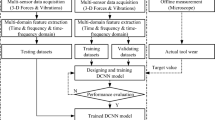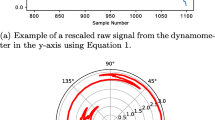Abstract
During machining processes, accurate prediction of cutting tool wear is prominent to prevent ineffective tool utilisation and significant resource waste. Tool wear conditions and progression involve complex physical mechanisms, and a promising approach is to deploy heterogeneous sensors and design a deep learning algorithm to conduct real-time tool wear monitoring and precious prediction. To tackle the challenge of deep learning algorithms in processing complex signals from heterogeneous sensors, in this paper, a systematic methodology is designed to combine signal de-noising, feature extraction, feature optimisation and deep learning-based prediction. In more details, the methodology is comprised of the following three steps: (i) signal de-noising is carried out by a designed Hampel filter-based method to eradicate random spikes and outliers in the signals for raw data quality enhancement; (ii) features extracted from heterogeneous sensors in the time and frequency domains are optimised using designed recursive feature elimination and cross-validation (RFECV)-based and Isomap-based methods; (iii) a convolutional neural networks (CNN) algorithm is devised to process the optimised features to implement tool wear prediction. In this paper, a case study showed that 80% features were reduced from the originally extracted features and 86% prediction accuracy was achieved based on the developed methodology. The presented methodology was benchmarked with several main-stream methodologies, and the superior performance of the methodology over those comparative methodologies in terms of prediction accuracy was exhibited.






















Similar content being viewed by others
Data availability
It declares that no data or materials are available for this research.
Code availability
It declares that codes are not available for this research.
References
Zhou Y, Xue W (2018) A multisensor fusion method for tool condition monitoring in milling. Sensors 18(11):3866
Thakre AA, Lad AV, Mala K (2019) Measurements of tool wear parameters using machine vision system. Modelling and Simulation in Engineering 2019(9):1–9
Alagan NT, Hoier P, Zeman P, Klement U, Beno T, Wretland A (2019) Effects of high-pressure cooling in the flank and rake faces of WC tool on the tool wear mechanism and process conditions in turning of alloy 718. Wear 434–435:102922
Patel VD, Gandhi AH (2016) Analytical and empirical modeling of wear and forces of CBN tool in hard turning—a review. Journal of The Institution of Engineers (India): Series C 98(4):507–513
Singh A, Ghosh S, Aravindan S (2020) Flank wear and rake wear studies for arc enhanced HiPIMS coated AlTiN tools during high speed machining of nickel-based superalloy. Surf Coat Technol 381:125190
Serin G, Sener B, Ozbayoglu AM, Unver HO (2020) Review of tool condition monitoring in machining and opportunities for deep learning. Int J Adv Manuf Technol 109(3–4):953–974
Kuntoğlu M, Aslan A, Sağlam H, Pimenov DY, Giasin K, Mikolajczyk T (2020) Optimization and analysis of surface roughness, flank wear and 5 different sensorial data via tool condition monitoring system in turning of AISI 5140. Sensors 20(16):4377
Zhang C, Yao X, Zhang J, Jin H (2016) Tool condition monitoring and remaining useful life prognostic based on a wireless sensor in dry milling operations. Sensors 16(6):795
Kothuru A, Nooka SP, Liu R (2019) Application of deep visualization in CNN-based tool condition monitoring for end milling. Procedia Manufacturing 34:995–1004
Kene AP, Choudhury SK (2019) Analytical modeling of tool health monitoring system using multiple sensor data fusion approach in hard machining. Measurement 145:118–129
de Calle KL, Ferreiro S, Arnaiz A, Sierra B (2019) Dynamic condition monitoring method based on dimensionality reduction techniques for data-limited industrial environments. Comput Ind 112:103114
Feng L, Zhao C, Huang B (2019) A slow independent component analysis algorithm for time series feature extraction with the concurrent consideration of high-order statistic and slowness. J Process Control 84:1–12
Madhusudana CK, Kumar H, Narendranath S (2019) Vibration-based fault diagnosis of a face milling tool using empirical mode decomposition features and artificial neural network. International Journal of Condition Monitoring 9(2):25–34
Mohanraj T, Shankar S, Rajasekar R, Deivasigamani R, Arunkumar PM (2019) Tool condition monitoring in the milling process with vegetable based cutting fluids using vibration signatures. Materials Testing 61(3):282–288
Plaza EG, López PJN, González EMB (2019) Efficiency of vibration signal feature extraction for surface finish monitoring in CNC machining. J Manuf Process 44:145–157
Bommert A, Sun XD, Bischl B, Rahnenführer J, Lang M (2020) Benchmark for filter methods for feature selection in high-dimensional classification data. Computational Statistics & Data Analysis 143:106839
Hira ZM, Gillies DF (2015) A review of feature selection and feature extraction methods applied on microarray data. Adv Bioinforma 2015:1–13
Chang W et al (2019) A machine learning-based prediction method for hypertension outcomes based on medical data. Diagnostics 9(4):178
Mao Y, Yang Y (2019) A wrapper feature subset selection method based on randomized search and multilayer structure. Biomed Res Int 2019:1–9
Chatterjee S, Dey D, Munshi S (2019) Integration of morphological pre-processing and fractal based feature extraction with recursive feature elimination for skin lesion types classification. Comput Methods Prog Biomed 178:201–218
Pes B (2019) Ensemble feature selection for high-dimensional data: a stability analysis across multiple domains. Neural Comput & Applic 32(10):5951–5973
Niu B, Sun J, Yang B (2020) Multisensory based tool wear monitoring for practical applications in milling of titanium alloy. Materials Today: Proceedings 22:1209–1217
Zhou C, Guo K, Yang B, Wang H, Sun J, Lu L (2020) Singularity analysis of cutting force and vibration for tool condition monitoring in milling. IEEE Access 7:134113–134124
Lai C, Guo S, Cheng L, Wang W (2017) A comparative study of feature selection methods for the discriminative analysis of temporal lobe epilepsy. Front Neurol 8:633
Wu W, Faisal S (2019) A data-driven principal component analysis-support vector machine approach for breast cancer diagnosis: comparison and application. Trans Inst Meas Control 42(7):1301–1312
Neef B, Bartels J, Thiede S (2018) Tool wear and surface quality monitoring using high frequency CNC machine tool current signature. Proceedings of the 16th IEEE International Conference on Industrial Informatics (INDIN), Porto 2018:1045–1050
Wang G, Yang Y, Li Z (2014) Force sensor based tool condition monitoring using a heterogeneous ensemble learning model. Sensors 14(11):21588–21602
Mali R, Telsang MT, Gupta TVK (2017) Real time tool wear condition monitoring in hard turning of Inconel 718 using sensor fusion system. Materials Today: Proceedings 4(8):8605–8612
Zhang Z, Chen H, Xu Y, Zhong J, Lv N, Chen S (2015) Multisensor-based real-time quality monitoring by means of feature extraction, selection and modeling for Al alloy in arc welding. Mech Syst Signal Process 60–61:151–165
Chen Y, Li H, Hou L, Wang J, Bu X (2018) An intelligent chatter detection method based on EEMD and feature selection with multi-channel vibration signals. Measurement 127:356–365
Pandiyan V, Caesarendra W, Tjahjowidodo T, Tan HH (2018) In-process tool condition monitoring in compliant abrasive belt grinding process using support vector machine and genetic algorithm. J Manuf Process 31:199–213
Simon GD, Deivanathan R (2019) Early detection of drilling tool wear by vibration data acquisition and classification. Manufacturing Letters 21:60–65
Lee J, Jeong JY, Jun CH (2020) Markov blanket-based universal feature selection for classification and regression of mixed-type data. Expert Syst Appl 158:113398
Li Y, Wang S, Umarov R, Xie B, Fan M, Li L, Gao X (2018) DEEPre: sequence-based enzyme EC number prediction by deep learning. Bioinformatics 34(5):760–769
Luo F, Wang M, Liu Y, Zhao X-M, Li A (2019) DeepPhos: prediction of protein phosphorylation sites with deep learning. Bioinformatics 35(16):2766–2773
Ngarambe J, Irakoze A, Yun GY, Kim G (2020) Comparative performance of machine learning algorithms in the prediction of indoor daylight illuminances. Sustainability 12(11):4471
Chen Y, Li H, Hou L, Bu X (2019) Feature extraction using dominant frequency bands and time-frequency image analysis for chatter detection in milling. Precis Eng 56:235–245
Maurya S, Singh V, Verma NK (2020) Condition monitoring of machines using fused features from EMD-based local energy with DNN. Journal of IEEE Sensors 20(15):8316–8327
Agogino A, Goebel K (2007), Milling Data Set - NASA Ames Prognostics Data Repository, Available: http://ti.arc.nasa.gov/project/prognostic-data-repository (last accessed on 6 December 2020)
Endevco, Endevco Model 7201-50, buy.endevco.com. https://buy.endevco.com/accelerometer/7201-accelerometer-5 (accessed Mar. 07, 2021).
Physical Acoustics (2011), WD - 100-900 kHz Wideband differential AE sensor, Acoustic Emission Systems and NDT Products by PHYSICAL ACOUSTICS, https://www.physicalacoustics.com/by-product/sensors/WD-100-900-kHz-Wideband-Differential-AE-Sensor (accessed Mar. 07, 2021).
Electronics datasheets (2011), SET-3B from Omron, www.electronicsdatasheets.com, https://www.electronicsdatasheets.com/manufacturers/omron/parts/set-3b#datasheet (accessed Mar. 07, 2021).
Flex-core, Hall Effect DC Current Transducer w/ Signal Conditioner, FLEX-CORE®. https://www.flex-core.com/products/transducers/current-transducers/dc-current-transducers/ctl-cta-dc-current-transducer/ (accessed Mar. 07, 2021).
Kennametal, “KICR - Indexable Inserts,” www.kennametal.com. https://www.kennametal.com/us/en/products/p.inserts-for-kicr-speb-inch.1157649.html#tad (accessed Mar. 07, 2021).
Yao Z, Xie J, Tian Y, Huang Q (2019) Using Hampel identifier to eliminate profile-isolated outliers in laser vision measurement. Sensors 2019:1–12
Pearson RK, Neuvo Y, Astola J, Gabbouj M (2016) Generalized Hampel Filters. EURASIP Journal on Advances in Signal Processing 2016(1):87
Ahmad MAF, Nuawi MZ, Abdullah S, Wahid Z, Karim Z, Dirhamsyah M (2015) Development of tool wear machining monitoring using novel statistical analysis method. I-kazTM, Procedia Engineering 101:355–362
Pappachan BK, Caesarendra W, Tjahjowidodo T, Wijaya T (2017) Frequency domain analysis of sensor data for event classification in real-time robot assisted deburring. Sensors 17(6):1247
Krishnakumar P, Rameshkumar K, Ramachandran KI (2015) Tool wear condition prediction using vibration signals in high speed machining (HSM) of Titanium (Ti-6Al-4V) alloy. Procedia Computer Science 50:270–275
Mu Y, Liu X, Wang L (2018) A Pearson’s correlation coefficient-based decision tree and its parallel implementation. Inf Sci 435:40–58
Gottwalt F, Chang E, Dillon T (2019) CorrCorr: A feature selection method for multivariate correlation network anomaly detection techniques. Computers & Security 83:234–245
Kalaiselvi B, Thangamani M (2020) An efficient Pearson correlation based improved random forest classification for protein structure prediction techniques. Measurement 162:107885
Nanda MA, Seminar KB, Nandika D, Maddu A (2018) A comparison study of kernel functions in the support vector machine and its application for termite detection. Information 9(1):5
Caggiano A, Angelone R, Napolitano F, Nele L, Teti R (2018) Dimensionality reduction of sensorial features by principal component analysis for ANN machine learning in tool condition monitoring of CFRP drilling. Procedia CIRP 78:307–312
Wang J, Xie J, Zhao R, Zhang L, Duan L (2017) Multisensory fusion based virtual tool wear sensing for ubiquitous manufacturing. Robot Comput Integr Manuf 45:47–58
Liu Q, Cai Y, Jiang H, Lu J, Chen L (2018) Traffic state prediction using ISOMAP manifold learning. Physica A: Statistical Mechanics and its Applications 506:532–541
Degenhardt D, Seifert S, Szymczak S (2019) Evaluation of variable selection methods for random forests and omics data sets. Brief Bioinform 20(2):492–503
Sharaff A, Gupta H (2019) Extra-Tree Classifier with Metaheuristics Approach for Email Classification. Advances in Intelligent Systems and Computing 924:189–197
Kahya MA, Altamir SA, Algamal ZY (2019) Improving firefly algorithm-based logistic regression for feature selection. Journal of Interdisciplinary Mathematics 22(8):1577–1581
Funding
This research was partially sponsored by the SABOT project funded by the IUK funder (UK). The research was also sponsored by the National Natural Science Foundation of China (Project No. 51975444).
Author information
Authors and Affiliations
Contributions
Xiaoyang Zhang is responsible for idea and methodology development, algorithm implementation and validation, manuscript writing; Sheng Wang, Weidong Li and Xin Lu are responsible for supervision, idea and methodology discussion, algorithm check and manuscript refinement; Apart from the above contributions, Weidong Li is also responsible for funding support and manuscript finalisation.
Corresponding author
Ethics declarations
Ethics approval
The authors claim that there are no ethical issues involved in this research.
Consent to participate
All the authors consent to participate in this research and contribute to the research.
Consent for publication
All the authors consent to publish the research. There are no potential copyright/plagiarism issues involved in this research.
Conflict of interest
The authors declare no competing interests.
Additional information
Publisher’s note
Springer Nature remains neutral with regard to jurisdictional claims in published maps and institutional affiliations.
Rights and permissions
About this article
Cite this article
Zhang, X., Wang, S., Li, W. et al. Heterogeneous sensors-based feature optimisation and deep learning for tool wear prediction. Int J Adv Manuf Technol 114, 2651–2675 (2021). https://doi.org/10.1007/s00170-021-07021-6
Received:
Accepted:
Published:
Issue Date:
DOI: https://doi.org/10.1007/s00170-021-07021-6




